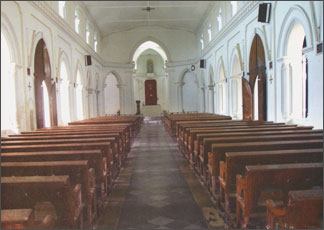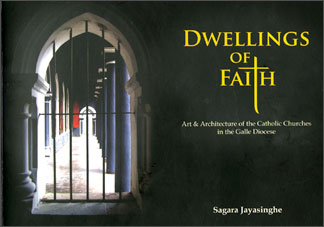Nostalgia
Down memory lane through the 'serious houses' in the
Galle Diocese:
by Aditha Dissanayake
|

Verandah through the Chapel window: St. Mary’s Cathedral, Galle
|
He stood alone on the beach staring at the waves and wishing them to
carry his thoughts home," Dear Father and Mother, of all our stations,
Hambanthota is the hottest and the driest. It is easy to put up with dry
heat than with humid heat. The chapel is old but good and decent.
The parish house is entirely new, built three years ago and is very
good.."
The year is 1903, the place, Hambanthota. The young man in
question...a figment of my imagination. The facts in the letter though,
are real. So too the note - "At the beginning of the year there was an
incident of small-pox. The Catholics made a vow to get a statue of St.
Sebastian for the church if they were spared from the epidemic. None of
them were attacked by the disease. On December 8th they fulfilled their
vow".
Even today, the words written in the Annual Letters of the Belgian
Province/1907-1908 sound true. "During the month of November and
December the waves of the sea, violently breaking against the shore,
washed away the public road, damaged the boundary wall of the church,
and even threatened the church itself. Things are now back to normal:
along the beach a line of rocks will in future break the violence of the
waves".
|

Interior of St. Mary’s Cathedral, Galle |
 |
These memories are recreated by Sagara Jayasinghe in his book,
'Dwellings of Faith' in which he focuses on the art and architecture of
the Catholic churches in the Galle Diocese.
"The salty breeze moves across. Tall trees toss their heads. Carefree
waves chuckle..." writes Jayasinghe, describing the atmosphere around
the Shrine of Our Lady of Matara so vividly that it's easy to feel the
salt of the wind on one's lips.
The story behind the statue of Our Lady provides a compelling read.
"The first Bishop of Galle, Rt. Rev. Dr. Joseph Van Reeth who was a
Belgian, had sent the statue to the then famous sculptor and painter, M.
Zeus of Gehent for repainting.
When the work was finished the statue was very cautiously shipped to
Matara in a cargo boat which set sail from Antwerp. The boat got caught
in a fierce storm in the North Sea and was almost wrecked.
However, the boat reached Middlesborough the following morning with
most of the cargo destroyed and some thrown overboard.
At Minicoy, too, the ship encountered trouble and once again a part
of the remaining cargo was thrown overboard and the ship reached our
shores without the statue.
Everybody concerned searched for the statue even in Belgium and
finally it was found in Middlesbrough.
An atheist, who possessed it demanded a fabulous sum of money in
exchange but was refused. This resulted in the statue being smashed in
the face badly damaging it. The statue was returned to M. Zeus for
repairing and repainting. Once again it was restored to its original
beauty. The Bishop of Galle undertook to bring the statue to Ceylon
after a visit to his homeland.
Some of the cargo including the wooden box containing the statue was
left behind as the ship had excess luggage, to be shipped in a cargo
boat a few days later. It was indeed a blessing that the statue was left
behind as the ship caught fire and some of the cargo was burnt and
buried in the Red Sea. Finally, the venerated statue was replaced in St.
Mary's Church on 12th November 1912, after an absence of 16 months,
amidst the pealing of festive bells.
Her third sea voyage was on December 26, 2004, 9.10 am. As the
tsunami swept most of the coastal belt the Church premises too were
washed away. The statue of the Virgin Mary once again went missing in
the ocean waters.
Adhering to her miraculous feat however the statue was found on 29th
December and returned to the Church."
Staring at the photos of the dome above the altar of St. Mary's
Cathedral in Galle, and the pews inside, it is easy to imagine how the
interior would have looked when it was first built.
For, the book effectively captures not only the architectural
qualities of the buildings, i.e structure, line and space but also the
sense of peace found in these dwellings of faith.
As Philip Larkin said of them "A serious house on serious earth it
is, In whose blent air all our compulsions meet,
Are recognised, and robed as destinies.
And that much never can be obsolete..."
[email protected]
|
